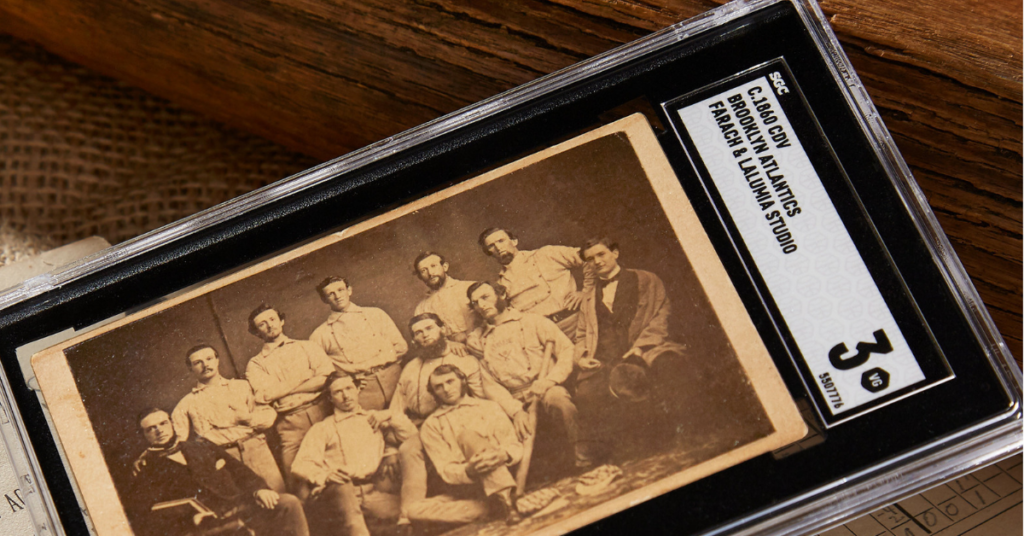Long before baseball was officially anointed America’s National Pastime — in truth, before even the first drop of blood was spilled in the American Civil War — there existed the Atlantic Base Ball Club of Brooklyn. In 1857, the Atlantics built baseball’s first dynasty, winning multiple league championships that started with an 11-1 record in 1859 and continued through an 1861 campaign shortened by the Civil War.
The Atlantics eventually relinquished the title in 1862 to archrival Eckford of Brooklyn before regaining the crown with an 18-0 record in 1865 and an 1866 season that saw the star-studded squad compile a 20-0-1 record. Heritage Auctions placed the spotlight on this pioneering group almost four years ago, presenting a slightly damaged SGC Authentic specimen that drew a winning bid of $179,250 in a July 2015 Platinum Night auction.
The members of the historic Atlantic nine who posed for this seminal artifact were headlined by Richard “Dickey” Pearce, who is widely believed to be one of the first baseball players to earn money as a professional. The Brooklyn native began playing with the Atlantics in 1856 and quickly established himself as a true pioneer of the game, despite having no experience playing baseball before joining the club. Tough and competitive, Pearce was just under 5 feet, 4 inches, but he weighed a sturdy 161 pounds and displayed a spry athleticism that belied his stocky build.
He initially assumed the short field position in the shallow outfield that essentially acted as a rover backing up the infield while the three infielders hugged their bags. Eventually, Pearce decided that he could make more of an impact shifting to the left of second base in the infield, a monumental move that created the now-established shortstop position. In what was then the barehanded era, he was an extremely sure-handed fielder with a strong, reliable arm — attributes that have come to define the position in the modern era.
Pearce’s lasting influence was felt not only through his stellar work in the field, but also with the bat, utilizing several techniques that forever changed the dynamic between batter, pitcher and infielders. Rather than swinging for the seats with every at-bat, he adhered to a philosophy of “scientific” or “intelligent” hitting that included reportedly being the first player to capitalize on the bunt, which was referred to by some at the time as the “tricky hit.” This tactic included utilizing sacrifice bunts and suicide squeezes.
“Yes, I was the first to introduce the bunt hit,” Pearce told Tim Murnane of the Boston Globe in December 1905. “While with the Atlantics, in ’67, the idea came to me, and I figured out just how a ball would bound when met from different angles. First I practiced bunting, then hitting the ball on top so that it would carom from the fair ground to the ground back of third base.”
That final statement hearkens to another Pearce specialty: the fair-foul hit, which relied on a loophole in the rules that wasn’t fixed until 1977. A trick play, the goal of the fair-foul hit was to tap the pitch into fair territory near the batter’s feet, then have it roll foul and out of a fielder’s reach while the hitter sprinted to first. Pearce mastered a spin on the ball that made it even more difficult to reach it in time to retire him at first.
Additionally, he emphasized place hitting to combat the early baseball rule that outs could be made by snagging a batted ball on one bounce. By viewing the position of the fielders and identifying open areas or weak spots to which he could (as Wee Willie Keeler famously said) “hit ’em where they ain’t,” Pearce allowed the field to open up for batters — and solidified his standing as the top practitioner of scientific batting.
While his career spanned from the game’s beginnings through the National Association and Major League Baseball’s earliest years, Pearce is known most for the advancements he brought to the game and his contribution to Atlantics championships in 1859-1861, 1864-1866 and 1969. His legacy to the game of baseball, along with that of his standout teammates, is once again presented by Heritage Auctions with an even finer version of the team’s 1860 CDV Brooklyn Atlantics Baseball Card, circa 1860. This influential monument to the game’s earliest days is just one of the many treasures available at Heritage’s April 2019 Sports Card Catalog Auction.
We offer free appraisals for sports memorabilia you are considering to sell. Visit our sports department for upcoming auctions and access to auction archives.
